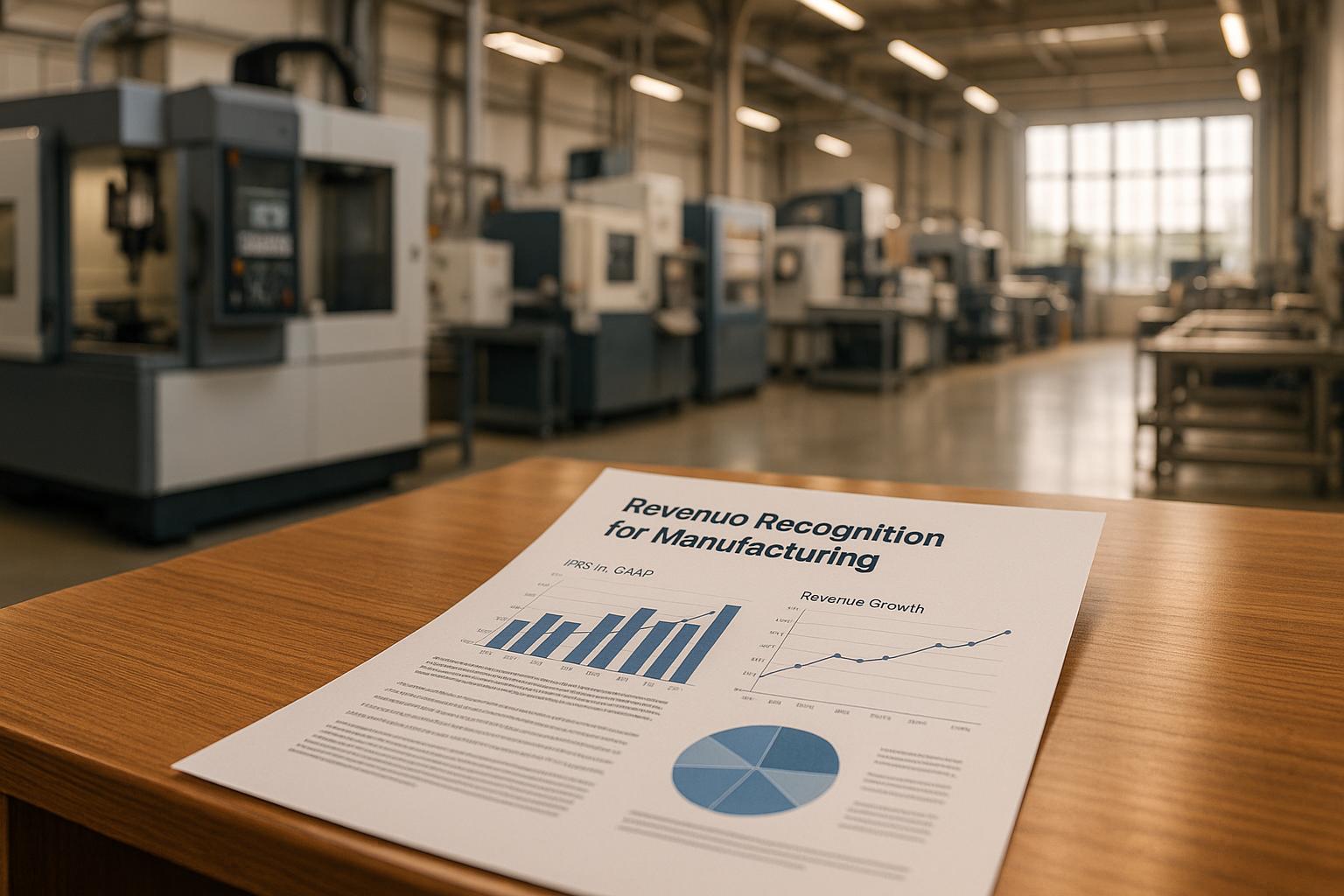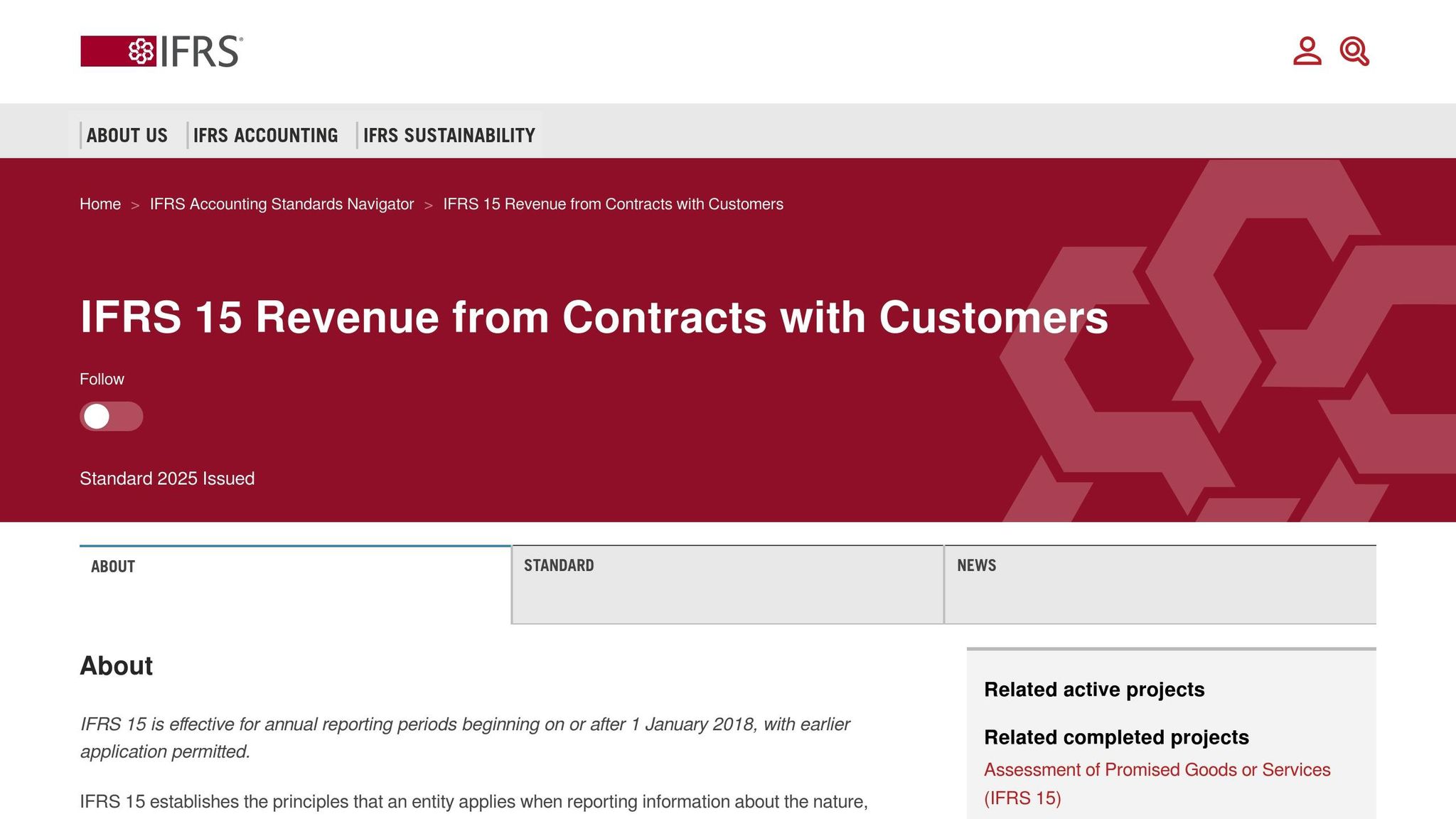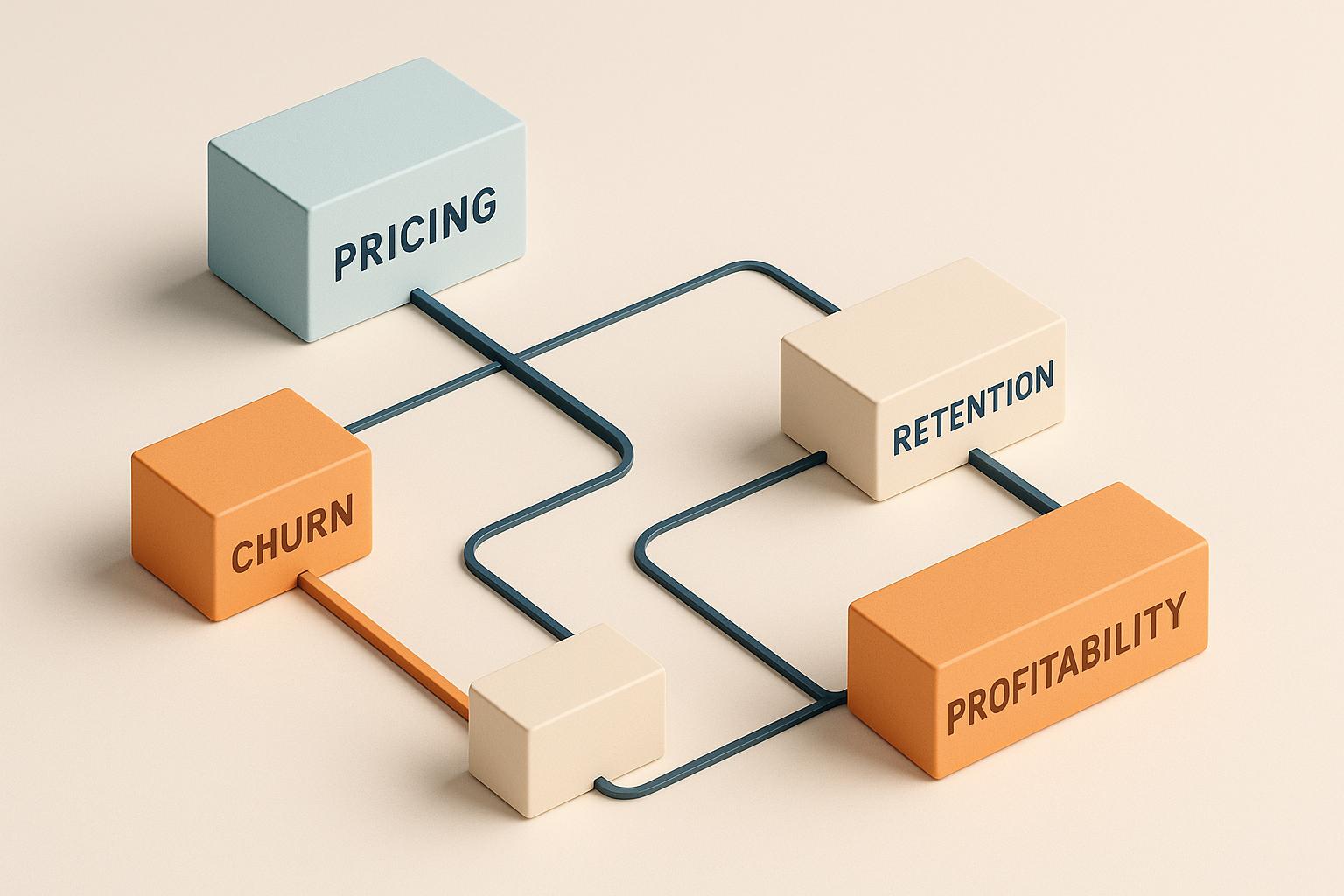IFRS vs. GAAP: Revenue Recognition for Manufacturing

For manufacturers, revenue recognition is a critical component of financial reporting. The two primary accounting standards - IFRS (International Financial Reporting Standards) and GAAP (Generally Accepted Accounting Principles) - offer different approaches to how and when revenue is recognized. Understanding these differences is essential for manufacturers, especially those operating internationally or managing complex contracts.
Key Takeaways:
- IFRS 15 and ASC 606 (GAAP) both use a five-step revenue recognition model, but their application varies.
- IFRS emphasizes principles-based judgment, offering flexibility but requiring more subjective decision-making.
- GAAP leans on rules-based guidance, providing detailed instructions that reduce ambiguity but limit flexibility.
- Manufacturers face challenges with contract modifications, variable consideration, and performance obligations, which are handled differently under each standard.
- U.S. manufacturers often follow GAAP for domestic reporting but may need IFRS for international operations, adding complexity.
Quick Overview:
- IFRS 15: Focuses on the transfer of control and requires more judgment in areas like contract modifications and performance obligations.
- ASC 606: Provides explicit rules for common scenarios, such as handling variable consideration and contract changes, making it easier to apply but less flexible.
For manufacturers, aligning revenue recognition practices with the appropriate standard is vital for accurate reporting, investor trust, and regulatory compliance. Below, we explore the nuances of each framework and their impact on manufacturing operations.
IFRS and GAAP Standards Overview
IFRS and GAAP provide the framework for revenue recognition in manufacturing financial reporting. These standards replaced older, industry-specific guidelines with unified methods that apply across all industries, including manufacturing operations with complex contracts. Below, we break down each standard's approach and the five-step model essential for recognizing revenue in manufacturing.
IFRS 15: Revenue from Contracts with Customers

Effective January 1, 2018, IFRS 15 reshaped global revenue recognition practices. This standard applies to all customer contracts, making it especially important for manufacturers dealing with diverse contract types.
Under IFRS 15, revenue recognition focuses on the transfer of control rather than the transfer of risks and rewards. For manufacturers, this means revenue is recognized when the customer gains control of the goods or services, which can vary depending on the terms of the contract.
The standard also requires companies to break down revenue by categories such as product lines, geographic regions, or contract durations. This helps stakeholders better understand a company’s performance. For manufacturers, this might mean disaggregating revenue based on product types or regions served.
Additionally, IFRS 15 introduces detailed disclosure requirements aimed at increasing transparency. Manufacturers must provide information about contract balances, performance obligations, and significant judgments. For example, they need to disclose remaining performance obligations, the transaction price allocated to those obligations, and the expected timing of revenue recognition.
ASC 606: Revenue from Contracts with Customers
ASC 606, the U.S. equivalent of IFRS 15, became effective for public companies starting with annual reporting periods after December 15, 2017. While ASC 606 aligns closely with IFRS 15, it retains some rules-based elements to address specific situations encountered by U.S. manufacturers.
This standard applies to all revenue from customer contracts, except for certain exclusions like lease income, insurance contracts, and financial instruments. For manufacturers, this includes everything from straightforward product sales to complex agreements like construction contracts or long-term service arrangements.
ASC 606 also provides detailed guidance on contract modifications, a common occurrence in manufacturing. Whether due to customer requests, design changes, or scope adjustments, the standard helps determine whether modifications should be treated as new contracts or adjustments to existing ones.
A key focus of ASC 606 is variable consideration, which is especially relevant in manufacturing contracts. These might include volume discounts, performance bonuses, or penalties. Companies must estimate variable consideration using either the expected value or the most likely amount, ensuring it’s probable that a significant reversal won’t occur.
Five-Step Revenue Recognition Model
Both IFRS 15 and ASC 606 follow the same five-step model for revenue recognition. This structured approach ensures consistency across industries, including manufacturing, while allowing flexibility for specific business scenarios.
-
Step 1: Identify the contract with a customer
Manufacturers must verify enforceable agreements with commercial substance and a high probability of collection. This can be challenging when dealing with framework agreements, master service agreements, or contracts with multiple amendments. -
Step 2: Identify performance obligations
This step involves pinpointing the distinct goods or services in the contract. Manufacturing contracts often bundle products with services like installation, training, or maintenance. Each distinct element may need separate revenue recognition. -
Step 3: Determine the transaction price
Here, manufacturers calculate the total consideration they expect to receive, including fixed payments and variable amounts like bonuses or penalties. For contracts with significant financing components, the time value of money must also be considered. -
Step 4: Allocate the transaction price
The total consideration is divided among the identified performance obligations based on their standalone selling prices. Manufacturers may use observable prices or estimation methods to determine these values. -
Step 5: Recognize revenue
Revenue is recognized when performance obligations are fulfilled by transferring control of goods or services to the customer. This can happen at a specific point in time (e.g., delivery of goods) or over time (e.g., constructing custom equipment). The timing of this transfer dictates when revenue appears on financial statements.
This five-step model ensures consistency in revenue recognition across various manufacturing contracts while accommodating the industry's unique challenges and complexities.
Main Differences Between IFRS and GAAP
Both IFRS 15 and ASC 606 follow the same five-step revenue recognition model, yet their underlying philosophies and applications lead to noticeable differences. These distinctions influence how contracts are interpreted, modified, and judged, directly affecting how revenue is recognized in daily practice.
Principles vs. Rules-Based Approaches
IFRS operates on a principles-based approach, which emphasizes professional judgment and the economic substance of transactions. This gives manufacturers more freedom to interpret standards based on their specific circumstances but requires a higher degree of subjective decision-making.
For example, under IFRS, determining whether a product and its installation service count as one or two performance obligations depends on whether the customer can independently benefit from each. This assessment involves analyzing the manufacturing process and the customer's capabilities, leaving room for interpretation.
GAAP, on the other hand, incorporates many principles-based elements through ASC 606 but still leans on detailed rules. U.S. manufacturers often find clear guidance for common scenarios, which reduces the need for extensive judgment. For instance, GAAP provides explicit instructions on handling contract modifications, variable consideration, and practical expedients.
This difference is particularly evident in collectibility assessments. IFRS bases collectibility on what is considered 'probable,' while GAAP requires it to be 'probable that the entity will collect substantially all of the consideration.' This subtle distinction can influence whether certain contracts qualify for revenue recognition, especially in markets with financial uncertainty or with customers facing economic challenges.
Performance Obligations and Contract Changes
The handling of performance obligations highlights another key difference. While both frameworks require identifying distinct goods and services in a contract, their criteria differ.
IFRS prioritizes the customer's perspective, asking whether the customer views bundled goods or services as separate benefits. This often leads to identifying more performance obligations in complex contracts, such as those in manufacturing.
GAAP, however, offers more specific guidance on identifying a series of distinct goods or services. For example, if a manufacturer provides recurring services like monthly equipment maintenance, GAAP outlines whether this should be treated as one performance obligation or multiple.
When it comes to contract modifications, IFRS allows more flexibility. Manufacturers can use professional judgment to decide whether a modification creates a new contract or adjusts an existing one, focusing on the commercial substance of the change.
GAAP, by contrast, has stricter criteria for contract modifications. Manufacturers benefit from detailed examples that guide them through common scenarios, but this approach leaves less room for adapting to unique situations.
Variable consideration - such as bonuses or penalties - also differs in treatment. While both standards require estimating these amounts, GAAP includes stricter guidelines for constraining estimates. This means manufacturers under ASC 606 tend to adopt a more conservative approach when including variable consideration in the transaction price.
Practical Options and Flexibility
In practical applications, GAAP and IFRS diverge further in their expedients and assessments. GAAP offers several practical expedients that simplify revenue recognition, many of which are unavailable under IFRS. For instance, ASC 606 allows manufacturers to apply revenue recognition rules to groups of similar contracts (the portfolio approach) rather than individual agreements. While IFRS permits this, it provides less detailed guidance on how to implement it.
Financing component assessments also vary. GAAP includes a practical expedient that lets companies ignore financing components for contracts with terms under one year, simplifying the process. IFRS, however, requires evaluating financing components on a case-by-case basis, regardless of contract duration.
The treatment of contract costs shows additional differences. ASC 606 provides clear guidance on capitalizing incremental costs, such as sales commissions and pre-production expenses, under specific conditions. IFRS lacks such detailed instructions, often requiring companies to refer to other standards for guidance.
Even disclosure requirements differ between the two frameworks. While both demand extensive revenue-related disclosures, GAAP specifies categories for disaggregating revenue and reporting remaining performance obligations. IFRS gives companies more leeway in deciding how to present these disclosures.
Finally, the transition methods for adopting these standards varied significantly. ASC 606 offered more transition relief and practical expedients for U.S. companies, while IFRS 15 provided fewer shortcuts. This difference influenced how manufacturers initially adopted the standards and continues to shape their ongoing application.
These distinctions underscore the importance of tailored financial strategies to manage compliance with either IFRS or GAAP effectively, ensuring alignment with the chosen framework's requirements and expectations.
IFRS vs. GAAP Comparison Table
Key Standards Comparison
Here’s a breakdown of the main differences between IFRS 15 and ASC 606 when it comes to revenue recognition in manufacturing:
| Aspect | IFRS 15 | ASC 606 (U.S. GAAP) |
|---|---|---|
| Variable Consideration Constraint | Includes variable consideration only if it is highly probable that a significant revenue reversal won't occur. | Includes variable consideration only if it is probable that a significant revenue reversal won't occur. |
| Probability Threshold | Defined as "more likely than not" (greater than 50%). | Interpreted as "likely to occur" (around 70% or higher). |
| Contract Modifications | Assessed based on whether the additional goods or services are distinct and the transaction price reflects standalone selling prices; requires significant judgment. | Offers detailed guidance with specific examples to determine if modifications are treated as separate contracts or adjustments to existing ones. |
| Onerous Contracts | Addressed under IAS 37; provisions are recognized at the contract level when unavoidable costs exceed expected benefits. | No broad guidance within ASC 606; loss provisions rely on other Codification Topics and may apply at the contract or performance obligation level. |
| Contract Cost Impairment | Allows reversal of impairment losses on capitalized contract costs if the conditions causing the impairment improve. | Does not allow reversal of impairment losses; once impaired, the loss is permanent. |
| Practical Expedients | Limited guidance, often requiring evaluations on a case-by-case basis. | Extensive practical expedients, including portfolio approaches and exemptions for financing components in contracts lasting under one year. |
This table highlights the core differences in revenue recognition under IFRS 15 and ASC 606, helping manufacturers navigate the complexities of both U.S. and global reporting standards.
For instance, IFRS uses a more flexible approach to contract modifications, focusing on economic substance, while ASC 606 provides clear examples for specific scenarios. IFRS also requires provisions for onerous contracts under IAS 37, unlike ASC 606, which lacks comprehensive guidance in this area. Additionally, IFRS allows reversing contract cost impairments when conditions improve, whereas ASC 606 treats impairments as permanent.
When it comes to practical expedients, ASC 606 offers a broader range of options, such as exemptions for short-duration contracts, while IFRS often requires detailed, case-by-case evaluations.
These differences carry regulatory and operational implications, which will be explored further in the next section focused on U.S. manufacturing companies.
Impact on U.S. Manufacturing Companies
The differences between IFRS and GAAP have a noticeable influence on the financial practices of U.S. manufacturers. These differences go beyond accounting tweaks - they touch financial planning, investor communication, and staying aligned with regulations.
Financial Reporting and Tax Effects
How and when revenue is recognized plays a big role in shaping reported earnings and cash flow. The timing differences in revenue recognition under these standards can create fluctuations in reported profitability. While tax rules aren’t directly dictated by GAAP or IFRS, these variations can complicate tax planning and cash flow projections. Manufacturers must stay on top of these differences to ensure proper tax compliance.
These challenges become even more pronounced for companies with international operations.
Multinational Manufacturing Challenges
For U.S. manufacturers operating globally, the balancing act between GAAP and IFRS is no small feat. They need to produce consolidated financial statements under U.S. GAAP for domestic purposes while ensuring their foreign subsidiaries adhere to IFRS. This dual compliance can lead to added complexity, especially when timing differences in revenue recognition affect currency translation and hedging strategies.
To manage these challenges, companies must rely on systems capable of tracking and reconciling the differences between the two standards. For example, they need to maintain detailed records of how contracts are treated under each framework to avoid administrative errors. Communicating performance metrics to stakeholders familiar with different accounting rules adds another layer of difficulty, making robust systems and processes essential for consistent reporting across the board.
Business Process and System Changes
Meeting the requirements of ASC 606 and IFRS 15 often means manufacturers must overhaul their internal processes and systems. ERP systems may need upgrades to capture detailed contract data, which can impact capital budgets and extend project timelines. Similarly, contract management processes might require a revamp, ensuring that sales teams document performance obligations, standalone selling prices, and contract changes in line with accounting standards.
Financial planning and analysis processes also need fine-tuning. Forecasting models, budget plans, and management reports should provide clear insights into performance obligations and their recognition timelines. This ensures that decision-makers have the information they need to adapt to the timing differences in revenue recognition.
Cross-functional collaboration is now more important than ever. Decisions about revenue recognition often require input from sales, legal, operations, and finance teams. Clear communication and consistent decision-making processes are critical to applying these standards uniformly across all contracts and business units.
For manufacturers navigating both domestic and international markets, these challenges grow exponentially. They need systems and processes that can handle the dual demands of GAAP and IFRS, often requiring parallel tracking and reporting to stay compliant on both fronts.
sbb-itb-e766981
Financial Advisory Support for IFRS and GAAP Compliance
Successfully managing IFRS and GAAP revenue recognition is a challenge for many manufacturers due to the intricate technical requirements, system complexities, and constant need for compliance.
Compliance and Reporting Support
Advisory firms play a critical role in guiding manufacturers through the complexities of ASC 606 and IFRS 15, helping them avoid costly compliance errors. These experts understand the impact of contract changes, performance obligations, and timing differences on financial statements under each framework. By collaborating closely with finance teams, they help establish consistent revenue recognition policies that meet both domestic and international reporting standards.
The process usually begins with a thorough evaluation of existing contracts and revenue streams. Advisors review manufacturing agreements, service contracts, and multi-element arrangements to identify compliance gaps. From there, they create standardized procedures for assessing contracts, ensuring sales teams capture the necessary data for accurate revenue recognition.
Advisory services also improve internal processes by refining documentation standards and preparing companies for external audits. Manufacturers are required to maintain detailed records to justify compliance decisions, and advisors ensure these records align with regulatory expectations.
For multinational companies, navigating the differences between GAAP and IFRS can be particularly challenging. Advisors with expertise in both frameworks assist in preparing consolidated financial statements while ensuring that subsidiaries remain compliant with local standards. This dual-framework expertise is essential for maintaining accuracy across global operations.
Phoenix Strategy Group addresses these challenges with fractional CFO services, embedding experienced financial professionals into manufacturing operations. Their team works alongside internal finance departments to implement strong revenue recognition processes, establish effective controls, and maintain compliance as standards evolve.
In addition to expert advisory support, leveraging advanced technology is essential for maintaining long-term compliance.
Technology and Expert Guidance
Modern revenue recognition compliance depends on automated systems that can handle complex calculations and maintain reliable audit trails. Advisors assist manufacturers in implementing revenue recognition software that integrates seamlessly with ERP and CRM systems. These tools are indispensable for meeting the requirements of ASC 606 and IFRS 15, streamlining processes, improving accuracy, and ensuring readiness for audits.
The best revenue recognition platforms offer advanced reporting and analytics, automation for complex calculations, scalability to support business growth, and customization options tailored to manufacturing needs. A user-friendly interface is equally important, enabling cross-functional teams to adapt to new systems and processes efficiently.
Successful implementation involves assessing specific business needs, evaluating total cost of ownership, and prioritizing solutions with strong customer support. Financial advisors guide manufacturers through every step - from vendor selection to system configuration and staff training - helping minimize operational disruptions during the transition.
Real-time data and analytics from these platforms provide executives with a clear view of revenue pipelines, contract performance, and compliance status across various business units and regions. For example, companies using Sage Intacct have reported faster close times, increased productivity, and significant ROI.
Emerging technologies like AI and machine learning are now being used to predict revenue timing and identify potential compliance issues before they arise. Advisors with expertise in technology help manufacturers evaluate these tools and determine their compatibility with specific business models.
Phoenix Strategy Group combines expert advisory services with advanced technology to further improve revenue recognition accuracy. Their approach reduces manual errors, mitigates compliance risks, and safeguards businesses from penalties and reputational harm.
Conclusion
Grasping the distinctions between IFRS and GAAP revenue recognition standards is crucial for U.S. manufacturers. While both frameworks follow a five-step model, their differing approaches significantly impact financial reporting, compliance, and strategic planning. Addressing these differences is key to managing the challenges posed by dual frameworks.
The rules-based structure of GAAP offers detailed guidance, which many U.S. manufacturers rely on to ensure consistency across their operations. However, this level of detail can sometimes restrict flexibility, especially when handling intricate manufacturing contracts or adapting to new market trends. On the other hand, IFRS's principles-based framework allows for more interpretive freedom but demands a higher degree of professional judgment, posing difficulties for companies without extensive accounting expertise.
For manufacturers operating globally, these differences take on even greater importance. Companies must juggle diverse requirements for contract modifications, identifying performance obligations, and applying practical expedients, all while ensuring their consolidated financial statements remain accurate. The challenge grows when factoring in varying effective dates, transition methods, and disclosure rules across different regions.
Key Points for Manufacturers
Manufacturers should prioritize creating strong revenue recognition processes that address both domestic and international reporting needs. Investing in advanced systems and expertise is essential for managing complex contracts, maintaining precise documentation, and leveraging modern revenue recognition platforms to minimize errors and enhance scalability. As noted earlier, robust ERP and contract management systems play a pivotal role in this effort.
With accounting standards continually evolving, staying informed about regulatory updates and new guidance is critical. Partnering with seasoned financial advisors can help companies navigate these complexities while staying focused on their core manufacturing activities. For instance, Phoenix Strategy Group's fractional CFO services offer specialized expertise to implement effective revenue recognition systems and ensure compliance with multiple frameworks.
Ultimately, manufacturers must align their choice of framework with their operational and strategic priorities. Regardless of which framework is adopted, accurate revenue recognition strengthens decision-making, builds investor trust, and lays the foundation for sustainable growth.
FAQs
How do differences between IFRS and GAAP impact revenue recognition for U.S. manufacturers with global operations?
Differences Between IFRS and GAAP in Revenue Reporting
When it comes to revenue recognition, IFRS and GAAP take different approaches, and these differences can have a big impact on how U.S. manufacturers with international operations handle their financial reporting.
IFRS leans on a principles-based approach, which gives companies more flexibility and room for judgment when recognizing revenue. On the other hand, GAAP is rules-based, offering a more structured and consistent framework. This contrast can lead to some notable variations in how financial information is reported.
For manufacturers working across borders, these distinctions can make compliance and comparability more challenging. For instance, under IFRS, revenue might be recognized sooner in some situations, which could result in discrepancies when reconciling financial statements between jurisdictions. That’s why it’s crucial for businesses to fully grasp these differences to ensure accurate and consistent reporting worldwide.
What challenges do manufacturers face when applying the five-step revenue recognition model under IFRS 15 and ASC 606?
Manufacturers face a variety of challenges when applying the five-step revenue recognition model outlined in IFRS 15 and ASC 606. A common difficulty is pinpointing and separating performance obligations in contracts that bundle multiple goods or services. This task can be both time-consuming and requires meticulous attention to detail to meet compliance standards.
Another tricky area is figuring out the transaction price, particularly when contracts include variable elements like discounts, rebates, or performance-based bonuses. Allocating that price to individual performance obligations becomes even more complicated when dealing with contracts that have detailed or layered terms. For businesses managing a high volume of transactions or operating on subscription-based models, automating revenue recognition without sacrificing accuracy can be an ongoing struggle.
To navigate these challenges, manufacturers must establish strong systems and processes. This not only ensures compliance and precise financial reporting but also helps them stay flexible as standards continue to evolve.
Why should manufacturers consider both rules-based and principles-based approaches to revenue recognition, and how can they effectively apply these frameworks?
Manufacturers can gain an edge by leveraging both rules-based and principles-based approaches to revenue recognition, as each brings distinct advantages. Rules-based standards provide clear, detailed instructions, minimizing uncertainty and promoting consistency across financial reporting. Meanwhile, principles-based standards allow greater flexibility, enabling companies to use professional judgment to better capture the economic reality of their transactions.
To strike the right balance, manufacturers should align their practices with key standards like ASC 606, which focuses on recognizing revenue in a way that reflects the actual transfer of goods or services. This means blending the precision of rules with the adaptability of principles, ensuring compliance while delivering financial reports that are both accurate and transparent.




